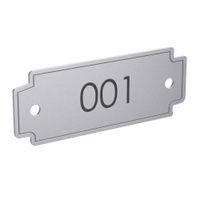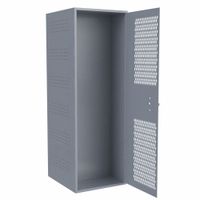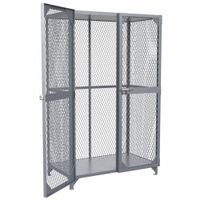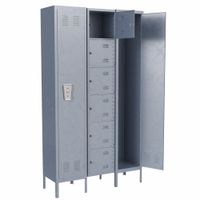Call +(254) 703 030 000 / 751 483 999 / 721 704 777
- Home
- Material Handling
- Storage Workspace
- Lockers
.....Read More
Frequently Asked Questions
What are the different types of lockers available?
Lockers come in various types, each designed to meet specific needs and environments. Here are some common types:
1. **Standard Lockers**: Typically found in schools and gyms, these are single or multi-tier units with a simple lock mechanism. They are made of metal or plastic and offer basic storage.
2. **Ventilated Lockers**: Similar to standard lockers but with perforations or mesh for airflow, ideal for storing items that need to dry, like sports gear.
3. **Electronic Lockers**: Equipped with digital locks, these offer enhanced security and convenience. Users can access them via PIN codes, RFID cards, or biometric systems.
4. **Smart Lockers**: Integrated with IoT technology, these lockers provide advanced features like remote access, usage tracking, and notifications. They are used in offices, package delivery, and retail.
5. **Parcel Lockers**: Designed for package delivery and collection, these lockers are often found in residential complexes and retail locations. They can be accessed by recipients using a code or app.
6. **Laptop/Device Lockers**: Specifically designed to store and charge electronic devices, these lockers are used in schools, offices, and libraries.
7. **Heavy-Duty Lockers**: Built for industrial environments, these lockers are made of robust materials to withstand harsh conditions and secure valuable tools and equipment.
8. **Personal Storage Lockers**: Smaller units for personal items, often used in workplaces or public spaces for temporary storage.
9. **Coin-Operated Lockers**: Found in public places like train stations and amusement parks, these require a coin or token to access, providing short-term storage.
10. **Wooden Lockers**: Offering an aesthetic appeal, these are used in upscale environments like spas and country clubs.
11. **Wire Mesh Lockers**: Used in industrial settings for visibility and ventilation, suitable for storing tools and equipment.
Each type serves a unique purpose, catering to different security, accessibility, and environmental needs.
How do I choose the right locker for my needs?
To choose the right locker for your needs, consider the following factors:
1. **Purpose**: Determine what you will store. For personal items, a small locker may suffice, while larger items or equipment may require a bigger one.
2. **Size**: Assess the dimensions of the items you plan to store. Ensure the locker is spacious enough to accommodate them comfortably.
3. **Location**: Decide where the locker will be placed. Indoor lockers may differ from outdoor ones in terms of material and durability.
4. **Material**: Choose a material based on the environment. Metal lockers are sturdy and secure, while plastic lockers are resistant to moisture and corrosion, making them ideal for humid areas.
5. **Security**: Evaluate the level of security needed. For high-value items, opt for lockers with advanced locking mechanisms like electronic locks or biometric systems.
6. **Ventilation**: If storing items that require air circulation, select lockers with ventilation features to prevent mold and odor buildup.
7. **Accessibility**: Consider how often you need to access the locker. For frequent access, ensure the locker is easily reachable and has a user-friendly lock.
8. **Aesthetics**: If appearance matters, choose a locker that complements the surrounding decor, especially in public or professional settings.
9. **Budget**: Set a budget and find a locker that meets your needs without overspending. Balance cost with quality and features.
10. **Customization**: Some lockers offer customization options like adjustable shelves or additional compartments, which can be beneficial for specific storage needs.
11. **Brand and Warranty**: Opt for reputable brands that offer warranties, ensuring reliability and support in case of defects or issues.
By considering these factors, you can select a locker that effectively meets your storage requirements.
What materials are lockers typically made from?
Lockers are typically made from a variety of materials, each chosen for its specific properties to suit different environments and uses. The most common materials include:
1. **Metal**: Predominantly steel, metal lockers are the most common type found in schools, gyms, and workplaces. They are valued for their durability, strength, and security. Steel lockers are often coated with a powder finish to prevent rust and corrosion, making them suitable for high-traffic areas.
2. **Plastic**: High-density polyethylene (HDPE) and other robust plastics are used to make lockers that are resistant to moisture, rust, and corrosion. These are ideal for environments with high humidity, such as swimming pools and outdoor settings. Plastic lockers are also lightweight and available in a variety of colors.
3. **Laminate**: These lockers are constructed with a core material, often particleboard or MDF, covered with a laminate finish. They offer a more aesthetically pleasing appearance and are often used in office settings or upscale facilities. Laminate lockers are resistant to scratches and dents but may not be as durable as metal or plastic in high-impact environments.
4. **Wood**: Less common than metal or plastic, wood lockers are typically found in high-end facilities like country clubs or executive offices. They offer a classic and elegant look but require more maintenance to protect against moisture and wear.
5. **Phenolic**: Made from layers of paper or fabric impregnated with resin, phenolic lockers are extremely durable and resistant to water, bacteria, and graffiti. They are often used in environments that require high hygiene standards, such as hospitals and laboratories.
Each material offers distinct advantages, and the choice often depends on the specific needs of the environment, such as durability, aesthetics, and resistance to environmental factors.
How secure are standard lockers compared to industrial lockers?
Standard lockers and industrial lockers differ significantly in terms of security features, construction materials, and intended use, which affects their overall security.
Standard lockers are typically used in schools, gyms, and offices. They are often made from lighter materials like thin-gauge steel or plastic, which makes them more susceptible to forced entry. The locking mechanisms in standard lockers are usually basic, such as padlocks or built-in combination locks, which can be vulnerable to picking or cutting. These lockers are designed for convenience and cost-effectiveness rather than high security, making them suitable for environments where the risk of theft is relatively low.
In contrast, industrial lockers are designed for use in more demanding environments such as factories, warehouses, and military facilities. They are constructed from heavier-gauge steel or other robust materials, providing greater resistance to physical attacks. Industrial lockers often feature advanced locking mechanisms, such as electronic locks, keycard systems, or high-security padlocks, which offer enhanced protection against unauthorized access. Additionally, they may include reinforced doors, concealed hinges, and tamper-proof features to further deter break-ins.
The security of industrial lockers is generally superior due to their durable construction and sophisticated locking systems. They are built to withstand harsh conditions and potential security threats, making them suitable for storing valuable or sensitive items. However, the increased security comes at a higher cost, which may not be justified in low-risk environments where standard lockers suffice.
In summary, while standard lockers offer basic security suitable for low-risk settings, industrial lockers provide enhanced protection through stronger materials and advanced locking mechanisms, making them more secure for high-risk environments.
Can lockers be customized for specific uses?
Yes, lockers can be customized for specific uses. Customization options include:
1. **Size and Dimensions**: Lockers can be tailored to fit specific spaces or accommodate particular items, such as sports equipment, musical instruments, or large bags.
2. **Material**: Depending on the environment, lockers can be made from various materials like metal, plastic, or wood. For example, plastic lockers are ideal for wet areas like swimming pools, while metal lockers are suitable for schools and gyms.
3. **Security Features**: Lockers can be equipped with different locking mechanisms, such as combination locks, key locks, electronic locks, or RFID systems, to enhance security based on user needs.
4. **Ventilation**: For uses requiring airflow, such as storing gym clothes or damp items, lockers can be designed with perforated doors or sides to improve ventilation.
5. **Interior Configuration**: The interior can be customized with shelves, hooks, or compartments to organize specific items, such as laptops, helmets, or personal belongings.
6. **Aesthetic Design**: Lockers can be customized in various colors, finishes, and designs to match the decor of the environment, whether it’s a school, office, or recreational facility.
7. **Technology Integration**: Modern lockers can include charging ports for electronic devices, digital interfaces for easy access, or smart technology for tracking usage and availability.
8. **Special Features**: For specific industries, lockers can be designed with features like fire resistance, antimicrobial surfaces, or soundproofing.
9. **Accessibility**: Lockers can be customized to be ADA-compliant, ensuring they are accessible to individuals with disabilities.
These customizations allow lockers to meet the unique requirements of different environments, enhancing functionality and user experience.
What are the dimensions of a standard locker?
The dimensions of a standard locker can vary depending on the context and the specific use case, such as in schools, gyms, or workplaces. However, a common size for a standard single-tier locker is approximately 12 inches wide, 18 inches deep, and 72 inches high (30.5 cm wide, 45.7 cm deep, and 182.9 cm high).
In multi-tier configurations, such as double-tier or triple-tier lockers, the height is divided among the tiers, but the width and depth generally remain the same. For example, a double-tier locker might be 12 inches wide, 18 inches deep, and 36 inches high per compartment.
These dimensions can vary based on manufacturer specifications and regional standards, so it's important to check the specific requirements or standards applicable to the intended use.
How do I maintain and clean lockers?
To maintain and clean lockers effectively, follow these steps:
1. **Regular Inspection**: Check lockers periodically for any signs of damage, rust, or wear. Address issues promptly to prevent further deterioration.
2. **Empty Contents**: Before cleaning, ensure all items are removed from the lockers. This allows for thorough cleaning and prevents damage to personal belongings.
3. **Dusting**: Use a microfiber cloth or duster to remove dust and debris from the interior and exterior surfaces. Pay attention to corners and crevices.
4. **Cleaning Solution**: Prepare a mild cleaning solution using water and a few drops of dish soap. Avoid harsh chemicals that can damage the locker’s finish.
5. **Wiping Down**: Dampen a cloth with the cleaning solution and wipe down all surfaces, including shelves and doors. For stubborn stains, let the solution sit for a few minutes before wiping.
6. **Rinsing**: Use a clean, damp cloth to remove any soap residue. Ensure all surfaces are free from cleaning solution to prevent streaks or damage.
7. **Drying**: Thoroughly dry the lockers with a clean towel to prevent rust and water spots. Ensure all moisture is removed, especially from metal lockers.
8. **Deodorizing**: To keep lockers smelling fresh, place a small container of baking soda or a dryer sheet inside. Replace regularly to maintain effectiveness.
9. **Lubrication**: Apply a light lubricant to hinges and locks to ensure smooth operation. Use a silicone-based spray to avoid attracting dust.
10. **Organizing**: Encourage users to keep lockers organized and clean. Provide guidelines for proper storage and regular cleaning.
11. **Security Check**: Regularly test locks and mechanisms to ensure they function correctly. Replace or repair any faulty components immediately.
By following these steps, lockers will remain clean, functional, and in good condition for extended use.






